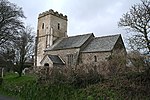Sampford Courtenay

Sampford Courtenay is a village and civil parish in West Devon in England, most famous for being the place where the Western Rebellion, otherwise known as the Prayerbook rebellion, first started, and where the rebels made their final stand. It has a population of around 600.The Church of St Andrew is mainly built of granite and has an elegant tower.Between 1867 and 1972, the village was served by the nearby Sampford Courtenay railway station at Belstone Corner. The station reopened for the heritage Dartmoor Railway between 2002 and 2021, after which it closed permanently. Network Rail reclaimed ownership of the Dartmoor line between Yeoford and Okehampton in 2021, but have no plans to reopen the station.
Excerpt from the Wikipedia article Sampford Courtenay (License: CC BY-SA 3.0, Authors, Images).Sampford Courtenay
A3072, West Devon Sampford Courtenay
Geographical coordinates (GPS) Address Nearby Places Show on map
Geographical coordinates (GPS)
| Latitude | Longitude |
|---|---|
| N 50.7923 ° | E -3.9451 ° |
Address
A3072
EX20 2TJ West Devon, Sampford Courtenay
England, United Kingdom
Open on Google Maps







